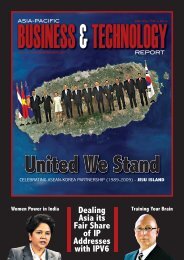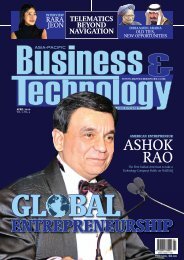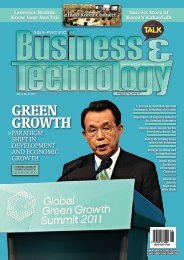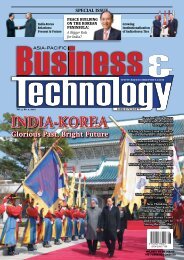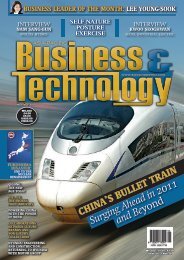Globalization of Korean Cuisine - Asia-Pacific Business and ...
Globalization of Korean Cuisine - Asia-Pacific Business and ...
Globalization of Korean Cuisine - Asia-Pacific Business and ...
Create successful ePaper yourself
Turn your PDF publications into a flip-book with our unique Google optimized e-Paper software.
USINESS<br />
Lean Transformations<br />
in <strong>Asia</strong>n Organizations<br />
By KeVin liu<br />
In <strong>Asia</strong>, the constantlychanging<br />
<strong>and</strong> increasingly<br />
competitive global<br />
market environments have<br />
prompted many enterprises<br />
in the region to focus on<br />
improving the speed <strong>and</strong><br />
efficiency <strong>of</strong> their respective<br />
manufacturing processes.<br />
many find that the traditional manual<br />
processes they have used in the past, based<br />
on the abundance <strong>of</strong> cheap skilled labor in<br />
the region, are no longer effective in keeping<br />
up with the pace <strong>of</strong> the current business<br />
environment. many have shifted paradigms<br />
<strong>and</strong> adopted lean transformation as a better<br />
manufacturing concept.<br />
To further improve efficiencies, these<br />
companies have integrated iT applications<br />
into their lean manufacturing environment<br />
to cope with the growing need <strong>of</strong> h<strong>and</strong>ling<br />
enormous amounts <strong>of</strong> data across all stages<br />
<strong>of</strong> the manufacturing process. This would<br />
result in a more accurate <strong>and</strong> better controlled<br />
h<strong>and</strong>ling <strong>of</strong> critical information in<br />
real time, thus improving the quality <strong>of</strong><br />
their just-in-time delivery systems.<br />
The manufacturing sector, however, is not<br />
the sole area undergoing lean transformations;<br />
it is occurring in other businesses <strong>and</strong><br />
operations across various industries as well.<br />
This includes everything from healthcare,<br />
development <strong>of</strong> high-technology products,<br />
iT operations, publishing, retail <strong>and</strong> any<br />
other business that involves certain forms<br />
<strong>of</strong> operations. lean transformation can help<br />
these industries identify <strong>and</strong> eliminate operational<br />
waste <strong>and</strong> other unnecessary activities,<br />
resulting in more streamlined <strong>and</strong><br />
16 | A-P BuSineSS & TeCHnology rePorT<br />
Lcs813 | Dreamstime.com<br />
more efficient operational processes.<br />
The challenge, however, for operations<br />
managers in the <strong>Asia</strong>n region, is to identify<br />
the specific lean strategies that will be applicable<br />
to their particular niche or industry.<br />
There are several elements that should be<br />
taken into consideration, from differences<br />
in the workforce culture to variations in the<br />
operational infrastructure. A particular lean<br />
strategy that is successful in one scenario<br />
may not have the same success in another.<br />
The following provides a brief look into<br />
the lean transformations underway right<br />
now in many <strong>Asia</strong>n organizations, <strong>and</strong> how<br />
these enterprises successfully implemented<br />
<strong>and</strong> made lean principles work for the betterment<br />
<strong>of</strong> their organizations.<br />
Lean manufacturing principles<br />
<strong>and</strong> the Toyota Lean manufacturing<br />
System<br />
For people not familiar with lean principles<br />
that are used in various industrial<br />
operations, the concept can be summarized<br />
as a set <strong>of</strong> tools <strong>and</strong> operational practices<br />
that involves all levels <strong>of</strong> the operational<br />
environment with the aim <strong>of</strong> eliminating<br />
material <strong>and</strong> procedural waste <strong>and</strong> increasing<br />
efficiencies. The result is a more streamlined<br />
<strong>and</strong> efficient production, with higher<br />
output quality, lower operational costs, <strong>and</strong><br />
faster cycle times.<br />
The following describes in brief some<br />
important facts about Toyota motor’s lean<br />
practices that were developed <strong>and</strong> perfected<br />
over the last five decades <strong>and</strong> applied in one<br />
<strong>of</strong> the most competitive <strong>of</strong> all industries.<br />
• Lean manufacturing System – the<br />
principles <strong>of</strong> lean transformation in<br />
use at present were based primarily<br />
on the Toyota Production System<br />
(TPS) used in Japan. many principles,<br />
words, <strong>and</strong> phrases used in modernday<br />
lean manufacturing lingo such<br />
as <strong>and</strong>on, kaizen <strong>and</strong> kanban were<br />
derived from the TPS.<br />
• heart <strong>of</strong> the Lean manufacturing<br />
System – if the heart <strong>of</strong> the<br />
lean manufacturing system can be<br />
summarized into one word, it is<br />
value. it is the one thing customers<br />
would want from a product or a service<br />
that they would pay for. lean<br />
manufacturing is all about focusing<br />
all operational resources into creating<br />
value-added characteristics for<br />
a product or service <strong>and</strong> identifying<br />
<strong>and</strong> eliminating all non-value added<br />
activities.<br />
• Giving Value to the Customer –<br />
in lean manufacturing, it is vital to<br />
identify what is important to the<br />
customer <strong>and</strong> what they consider<br />
as valuable to them. identifying<br />
such, the operations can now focus<br />
on adding this value into the products<br />
<strong>and</strong> services, thus aligning the<br />
manufacturing process to what the<br />
customer dem<strong>and</strong>s.<br />
• wastes – in a traditional manufacturing<br />
set-up, wastes are objects that<br />
were discarded or rejected. in lean<br />
manufacturing, what are considered<br />
wastes are not only objects but also<br />
processes that do not give value to<br />
the customer, while incurring cost<br />
to the company.<br />
• Continuous Improvement – in<br />
lean manufacturing, great focus<br />
is exerted towards continuous improvement.<br />
The whole operation<br />
should be open to changes that will<br />
improve any manufacturing process.<br />
Procedures <strong>and</strong> steps that are redundant<br />
are replaced or improved.<br />
• benefits to the Company – lean<br />
transformations can provide companies<br />
with the following improvements<br />
<strong>and</strong> benefits:<br />
* Increase in morale<br />
<strong>and</strong> productivity<br />
* Reduced defects in products<br />
delivered to the customer<br />
* Faster delivery time<br />
* Faster product marketability<br />
* Total customer satisfaction<br />
Lean Transformations in <strong>Asia</strong>n<br />
Economies<br />
emerging <strong>Asia</strong>n economies such as China<br />
<strong>and</strong> other Southeast <strong>Asia</strong>n countries<br />
have experienced tremendous growth in<br />
recent years <strong>and</strong> this can be attributed to<br />
more efficient <strong>and</strong> more productive manufacturing<br />
industries. Such improvements<br />
were achieved after adopting international<br />
management techniques <strong>and</strong> lean transformations<br />
in their operations.<br />
in China, tremendous change is occurring<br />
in both domestic <strong>and</strong> multinational companies,<br />
which are all focused on increasing<br />
productivity <strong>and</strong> achieving positive results.<br />
Workers now participate in kaizen events<br />
such as group problem-solving discussions.<br />
lean transformations not only occur in the<br />
manufacturing sector but also in other aspects<br />
<strong>of</strong> any business such as in accounting,<br />
finance <strong>and</strong> warehousing. All are now<br />
focused on the lean philosophy: everything<br />
begins <strong>and</strong> ends with the customer.<br />
Both small <strong>and</strong> multinational firms in<br />
Southeast <strong>Asia</strong> are adopting lean transformations,<br />
as the “just-in-time” philosophy allows<br />
them to compete on the global market. india’s<br />
manufacturing <strong>and</strong> service industries is<br />
also slowly adopting lean transformations,<br />
with large corporations such as Tata motors,<br />
Wipro <strong>and</strong> HCl leading the way with the aim<br />
<strong>of</strong> penetrating <strong>and</strong> operating in the global<br />
marketplace.<br />
making Lean Transformation<br />
work for your organization<br />
Despite the tremendous potential <strong>of</strong> lean<br />
principles, not all <strong>Asia</strong>n organizations have<br />
successfully implemented <strong>and</strong> achieved tangible<br />
results from their lean transformations.<br />
This can be attributed to many aspects but<br />
it all boils down to an organization’s commitment<br />
to change <strong>and</strong> continuous improvement.<br />
it has also been a norm in traditional <strong>Asia</strong>n<br />
organizations to rely on quick fixes <strong>and</strong> get<br />
immediate results. many tend to ab<strong>and</strong>on a<br />
program if they do not experience immediate<br />
gratification, thus causing the organization<br />
to lose focus on improvement programs<br />
such as lean transformation.<br />
Aside from getting the proper tools <strong>and</strong><br />
methodologies for lean transformation,<br />
an organization can also use the following<br />
guidelines to make lean principles work for<br />
them:<br />
• Start Small – lean transformation<br />
may seem like a major <strong>and</strong> radical<br />
change for organizations that are<br />
used to the traditional way <strong>of</strong> operations.<br />
Start by making small alterations<br />
on the flywheel <strong>of</strong> change <strong>and</strong><br />
continuously make small pushes to<br />
move forward. resistance to change<br />
in an organization can be addressed<br />
by making organizational structure<br />
changes or by conducting developmental<br />
training programs.<br />
• Follow Toyota’s Cultural Change<br />
model – The success <strong>of</strong> lean transformation<br />
in a particular organization<br />
is based not so much on the organization’s<br />
knowledge <strong>of</strong> lean tools but<br />
on its willingness to accept change.<br />
According to Toyota, there is an estimated<br />
2 to 4 percent in every organization<br />
that are willing to accept<br />
change, another 2 to 4 percent who<br />
resist <strong>and</strong> impede change, while the<br />
rest are just waiting to see what group<br />
will prevail over the other.<br />
• Traditional management focuses<br />
more on those who resist change<br />
– in Toyota’s Cultural Change model,<br />
management is urged to focus more<br />
on those willing to change by providing<br />
them with positive reinforcement<br />
<strong>and</strong> providing them with support for<br />
lean activities.<br />
• Learn from Successful Companies<br />
– lean transformation is also<br />
about employing best practices that<br />
are applicable to an organization. it is<br />
well to learn these best practices from<br />
organizations that have challenged<br />
their people to continuously improve<br />
<strong>and</strong> implement successful integrated<br />
lean principles into their operations –<br />
<strong>and</strong> which have achieved tremendous<br />
tangible results.<br />
• plan <strong>and</strong> make the Adjustment<br />
– An implementation plan is necessary<br />
for lean transformation <strong>and</strong> this<br />
should include <strong>and</strong> consider all the<br />
technical as well as the organizational<br />
development elements towards lean<br />
implementation. Such a plan should<br />
include the following aspects:<br />
* Lay a foundation <strong>of</strong> knowledge –<br />
teach people the tools, theories <strong>and</strong> methodologies<br />
they need; assign or hire lean experts<br />
that will work h<strong>and</strong>s-on throughout<br />
the transformation process<br />
* Create teams – These teams facilitate<br />
the teaching <strong>and</strong> training <strong>of</strong> organizational<br />
<strong>and</strong> development tools to improve team<br />
members’ s<strong>of</strong>t skills. Teams also promote<br />
communication as well as proper engagement<br />
throughout an organization.<br />
* Develop Vision – The leaders <strong>of</strong> an<br />
organization should use long-range planning<br />
tools in strategy deployment sessions<br />
to identify 3 to 5 year visions <strong>and</strong> breakthroughs<br />
as well as annual improvement<br />
goals<br />
• Use IT to Enable Lean Transformation<br />
– An organization’s Cio should<br />
be involved in designing <strong>and</strong> executing<br />
lean transformation. Workflows<br />
<strong>and</strong> process can be streamlined <strong>and</strong><br />
optimized by integrating iT technologies,<br />
eliminating manual processes,<br />
minimizing errors <strong>and</strong> improving efficiency.<br />
• Take the Lead – An organization’s<br />
leaders should take the lead in lean<br />
transformation to give it a better<br />
chance for success. A change in corporate<br />
mindset towards continuous<br />
improvement is not something that<br />
can be delegated to subordinates, but<br />
rather should be embraced by the<br />
leaders themselves – thus making<br />
good examples <strong>of</strong> themselves that the<br />
rest <strong>of</strong> the organization will follow.<br />
They should take the lead in aligning<br />
all organizational activities towards<br />
lean transformation goals <strong>and</strong> they<br />
should also constantly communicate<br />
these goals <strong>and</strong> visions to the whole<br />
organization on a regular basis. a-p<br />
FURThER READING:<br />
• iSix Sigma<br />
www.isixsigma.com<br />
• McKinsey Quarterly<br />
www.mckinseyquarterly.com<br />
• Lean Six Sigma <strong>Asia</strong><br />
www.lean-asia.com<br />
COMPANIES MENTIONED<br />
IN ThIS ARTICLE:<br />
• Toyota Motors<br />
www.toyota.com<br />
• Tata Motors<br />
www.tatamotors.com<br />
• Wipro<br />
www.wipro.com<br />
www.biztechreport.com<br />
S. Korea,<br />
China,<br />
japan to<br />
Finalize FTA<br />
Study before<br />
Trilateral<br />
Summit<br />
in 2012<br />
By eun-Jung Kim<br />
South Korea, China<br />
<strong>and</strong> Japan are to<br />
conclude a joint<br />
study on the feasibility<br />
<strong>of</strong> a trilateral free<br />
trade agreement (FTA)<br />
before their three-way<br />
summit next year.<br />
The agreement was made by<br />
South Korea’s Trade minister Kim<br />
Jong-hoon, Japan’s Trade minister<br />
Banri Kaieda, <strong>and</strong> China’s Trade<br />
minister Chen Deming during the<br />
8th trade minister summit held in<br />
Tokyo on April 24th.<br />
under the current situation<br />
where bilateral FTAs between<br />
South Korea <strong>and</strong> China, as well as<br />
South Korea <strong>and</strong> Japan, are facing<br />
setbacks, the joint study on the trilateral<br />
FTA that began last year is<br />
expected to address current snags.<br />
During the summit, the three<br />
nations discussed a three-way<br />
investment treaty, but failed to<br />
draw up conclusive details, with<br />
China taking a lukewarm stance.<br />
on the same day, China <strong>and</strong> Japan<br />
were eager to establish a FTA with<br />
South Korea, which had already<br />
signed an FTA with the european<br />
union <strong>and</strong> the united States. China<br />
urged South Korea to jointly<br />
declare a bilateral FTA talk at a trilateral<br />
summit slated for may 21st<br />
<strong>and</strong> 22nd.<br />
meanwhile, Japan requested<br />
South Korea to make changes on<br />
their decision to regulate imported<br />
Japanese agro-products after<br />
the outbreak <strong>of</strong> the Fukushima<br />
nuclear power plant accident.<br />
However, South Korea strongly<br />
opposed it as it is directly concerned<br />
with the health <strong>of</strong> people.<br />
The trade ministers <strong>of</strong> the three<br />
countries agreed that their governments<br />
should further reinforce<br />
information sharing against<br />
a possible disaster. a-p<br />
A-P BuSineSS & TeCHnology rePorT | 17



